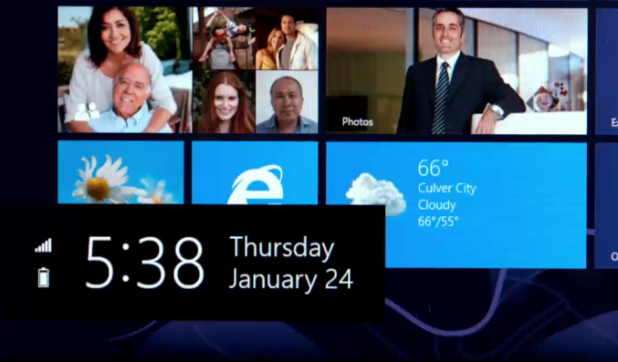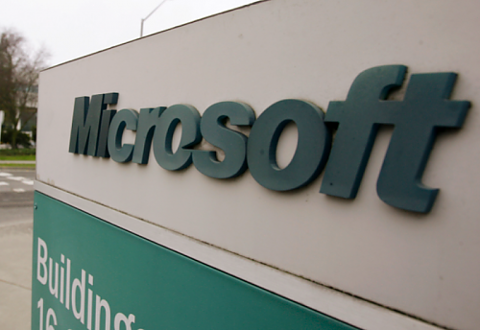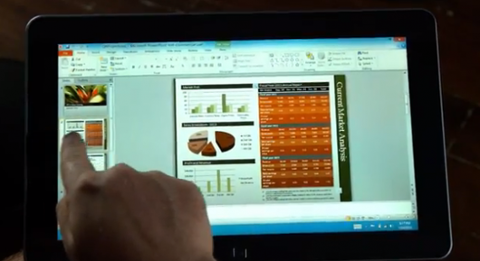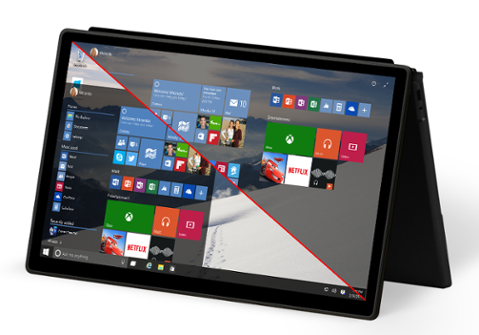 Some analysts believe Microsoft's attempt at a new interface basically doomed Windows 8.[/caption] Earlier this week, ZDNet columnist Steven Vaughan-Nichols wrote an article, “Windows: It’s over,” that sparked a lot of passionate online debate. His thesis was simple: Microsoft’s dominance of the computing market is coming to an end, accelerated by the incipient failure of Windows 8. “It looks like Microsoft is betting all its chips on the silly notion that Metro will be the one true interface for its entire PC and device line,” he wrote. “There's only one little problem with this idea. Sorry, but I have to say it again, look at the numbers: Metro-interface operating systems have already failed.” By “Metro,” Vaughan-Nichols is referring to the Windows 8 Start screen, which features colorful tiles linked to applications; the desktop interface, familiar to millions of Windows users, is buried behind one of those tiles. (Microsoft actually stopped using the “Metro” name after a shady copyright dispute with German conglomerate Metro AG, although sometimes it seems as if everyone in the tech industry still uses it.) Microsoft created Windows 8’s dual interface in the belief that it would help the operating system functionally equally well on tablets (where users could stay in the “Metro” interface and tap on the tiles to activate apps) and traditional PCs (where power users and office workers could switch over to the desktop to use legacy programs). But instead of conquering the mobile-device and PC worlds in a single stroke, Vaughan-Nichols suggests that Windows 8 alienated Windows’ traditional audience while failing to gain any traction with tablet owners. “The sum is that Microsoft is failing to hold on to the desktop market and that it has no impact whatsoever on smartphones and tablets,” he wrote. “Unless Microsoft changes course, this may be the end of the Windows domination period in end-using computing.” Some early numbers certainly appear to back up his assertions: research firm IDC estimated worldwide PC shipments in the first quarter of 2013 at 76.3 million units, down 13.9 percent from the same quarter in 2012, and placed part of the blame on Windows 8. “At this point, unfortunately, it seems clear that the Windows 8 launch not only failed to provide a positive boost to the PC market, but appears to have slowed the market,” Bob O’Donnell, IDC Program Vice President, Clients and Displays, wrote in a statement at the time. O’Donnell went on to blame Windows 8’s interface for many of the operating system’s problems. “While some consumers appreciate the new form factors and touch capabilities of Windows 8, the radical changes to the UI, removal of the familiar Start button, and the costs associated with touch have made PCs a less attractive alternative to dedicated tablets and other competitive devices.” (Just for good measure, Intel CEO Paul Otellini leapt atop that particular dog-pile, telling analysts and media on a conference call that Windows 8 “didn’t quite have that same kind of adoption curve” as its predecessors, and “requires a bit of training.”) Windows 8 certainly didn’t skyrocket Microsoft’s profits in the most recent quarter. On April 18, Microsoft reported quarterly revenues of $5.70 billion for its Windows division, a 23 percent increase from the same quarter a year ago. But as the company noted in a press release, “adjusting for the recognition of revenue related to the Windows Upgrade Offer, Windows Division non-GAAP revenue was flat.” That’s despite Microsoft’s massive Windows 8 advertising campaign, and the release of the sleek-and-shiny Surface Pro tablets.
Some analysts believe Microsoft's attempt at a new interface basically doomed Windows 8.[/caption] Earlier this week, ZDNet columnist Steven Vaughan-Nichols wrote an article, “Windows: It’s over,” that sparked a lot of passionate online debate. His thesis was simple: Microsoft’s dominance of the computing market is coming to an end, accelerated by the incipient failure of Windows 8. “It looks like Microsoft is betting all its chips on the silly notion that Metro will be the one true interface for its entire PC and device line,” he wrote. “There's only one little problem with this idea. Sorry, but I have to say it again, look at the numbers: Metro-interface operating systems have already failed.” By “Metro,” Vaughan-Nichols is referring to the Windows 8 Start screen, which features colorful tiles linked to applications; the desktop interface, familiar to millions of Windows users, is buried behind one of those tiles. (Microsoft actually stopped using the “Metro” name after a shady copyright dispute with German conglomerate Metro AG, although sometimes it seems as if everyone in the tech industry still uses it.) Microsoft created Windows 8’s dual interface in the belief that it would help the operating system functionally equally well on tablets (where users could stay in the “Metro” interface and tap on the tiles to activate apps) and traditional PCs (where power users and office workers could switch over to the desktop to use legacy programs). But instead of conquering the mobile-device and PC worlds in a single stroke, Vaughan-Nichols suggests that Windows 8 alienated Windows’ traditional audience while failing to gain any traction with tablet owners. “The sum is that Microsoft is failing to hold on to the desktop market and that it has no impact whatsoever on smartphones and tablets,” he wrote. “Unless Microsoft changes course, this may be the end of the Windows domination period in end-using computing.” Some early numbers certainly appear to back up his assertions: research firm IDC estimated worldwide PC shipments in the first quarter of 2013 at 76.3 million units, down 13.9 percent from the same quarter in 2012, and placed part of the blame on Windows 8. “At this point, unfortunately, it seems clear that the Windows 8 launch not only failed to provide a positive boost to the PC market, but appears to have slowed the market,” Bob O’Donnell, IDC Program Vice President, Clients and Displays, wrote in a statement at the time. O’Donnell went on to blame Windows 8’s interface for many of the operating system’s problems. “While some consumers appreciate the new form factors and touch capabilities of Windows 8, the radical changes to the UI, removal of the familiar Start button, and the costs associated with touch have made PCs a less attractive alternative to dedicated tablets and other competitive devices.” (Just for good measure, Intel CEO Paul Otellini leapt atop that particular dog-pile, telling analysts and media on a conference call that Windows 8 “didn’t quite have that same kind of adoption curve” as its predecessors, and “requires a bit of training.”) Windows 8 certainly didn’t skyrocket Microsoft’s profits in the most recent quarter. On April 18, Microsoft reported quarterly revenues of $5.70 billion for its Windows division, a 23 percent increase from the same quarter a year ago. But as the company noted in a press release, “adjusting for the recognition of revenue related to the Windows Upgrade Offer, Windows Division non-GAAP revenue was flat.” That’s despite Microsoft’s massive Windows 8 advertising campaign, and the release of the sleek-and-shiny Surface Pro tablets.
Windows: It’s Not Over (Yet)
[caption id="attachment_9290" align="aligncenter" width="618"]  Some analysts believe Microsoft's attempt at a new interface basically doomed Windows 8.[/caption] Earlier this week, ZDNet columnist Steven Vaughan-Nichols wrote an article, “Windows: It’s over,” that sparked a lot of passionate online debate. His thesis was simple: Microsoft’s dominance of the computing market is coming to an end, accelerated by the incipient failure of Windows 8. “It looks like Microsoft is betting all its chips on the silly notion that Metro will be the one true interface for its entire PC and device line,” he wrote. “There's only one little problem with this idea. Sorry, but I have to say it again, look at the numbers: Metro-interface operating systems have already failed.” By “Metro,” Vaughan-Nichols is referring to the Windows 8 Start screen, which features colorful tiles linked to applications; the desktop interface, familiar to millions of Windows users, is buried behind one of those tiles. (Microsoft actually stopped using the “Metro” name after a shady copyright dispute with German conglomerate Metro AG, although sometimes it seems as if everyone in the tech industry still uses it.) Microsoft created Windows 8’s dual interface in the belief that it would help the operating system functionally equally well on tablets (where users could stay in the “Metro” interface and tap on the tiles to activate apps) and traditional PCs (where power users and office workers could switch over to the desktop to use legacy programs). But instead of conquering the mobile-device and PC worlds in a single stroke, Vaughan-Nichols suggests that Windows 8 alienated Windows’ traditional audience while failing to gain any traction with tablet owners. “The sum is that Microsoft is failing to hold on to the desktop market and that it has no impact whatsoever on smartphones and tablets,” he wrote. “Unless Microsoft changes course, this may be the end of the Windows domination period in end-using computing.” Some early numbers certainly appear to back up his assertions: research firm IDC estimated worldwide PC shipments in the first quarter of 2013 at 76.3 million units, down 13.9 percent from the same quarter in 2012, and placed part of the blame on Windows 8. “At this point, unfortunately, it seems clear that the Windows 8 launch not only failed to provide a positive boost to the PC market, but appears to have slowed the market,” Bob O’Donnell, IDC Program Vice President, Clients and Displays, wrote in a statement at the time. O’Donnell went on to blame Windows 8’s interface for many of the operating system’s problems. “While some consumers appreciate the new form factors and touch capabilities of Windows 8, the radical changes to the UI, removal of the familiar Start button, and the costs associated with touch have made PCs a less attractive alternative to dedicated tablets and other competitive devices.” (Just for good measure, Intel CEO Paul Otellini leapt atop that particular dog-pile, telling analysts and media on a conference call that Windows 8 “didn’t quite have that same kind of adoption curve” as its predecessors, and “requires a bit of training.”) Windows 8 certainly didn’t skyrocket Microsoft’s profits in the most recent quarter. On April 18, Microsoft reported quarterly revenues of $5.70 billion for its Windows division, a 23 percent increase from the same quarter a year ago. But as the company noted in a press release, “adjusting for the recognition of revenue related to the Windows Upgrade Offer, Windows Division non-GAAP revenue was flat.” That’s despite Microsoft’s massive Windows 8 advertising campaign, and the release of the sleek-and-shiny Surface Pro tablets.
Some analysts believe Microsoft's attempt at a new interface basically doomed Windows 8.[/caption] Earlier this week, ZDNet columnist Steven Vaughan-Nichols wrote an article, “Windows: It’s over,” that sparked a lot of passionate online debate. His thesis was simple: Microsoft’s dominance of the computing market is coming to an end, accelerated by the incipient failure of Windows 8. “It looks like Microsoft is betting all its chips on the silly notion that Metro will be the one true interface for its entire PC and device line,” he wrote. “There's only one little problem with this idea. Sorry, but I have to say it again, look at the numbers: Metro-interface operating systems have already failed.” By “Metro,” Vaughan-Nichols is referring to the Windows 8 Start screen, which features colorful tiles linked to applications; the desktop interface, familiar to millions of Windows users, is buried behind one of those tiles. (Microsoft actually stopped using the “Metro” name after a shady copyright dispute with German conglomerate Metro AG, although sometimes it seems as if everyone in the tech industry still uses it.) Microsoft created Windows 8’s dual interface in the belief that it would help the operating system functionally equally well on tablets (where users could stay in the “Metro” interface and tap on the tiles to activate apps) and traditional PCs (where power users and office workers could switch over to the desktop to use legacy programs). But instead of conquering the mobile-device and PC worlds in a single stroke, Vaughan-Nichols suggests that Windows 8 alienated Windows’ traditional audience while failing to gain any traction with tablet owners. “The sum is that Microsoft is failing to hold on to the desktop market and that it has no impact whatsoever on smartphones and tablets,” he wrote. “Unless Microsoft changes course, this may be the end of the Windows domination period in end-using computing.” Some early numbers certainly appear to back up his assertions: research firm IDC estimated worldwide PC shipments in the first quarter of 2013 at 76.3 million units, down 13.9 percent from the same quarter in 2012, and placed part of the blame on Windows 8. “At this point, unfortunately, it seems clear that the Windows 8 launch not only failed to provide a positive boost to the PC market, but appears to have slowed the market,” Bob O’Donnell, IDC Program Vice President, Clients and Displays, wrote in a statement at the time. O’Donnell went on to blame Windows 8’s interface for many of the operating system’s problems. “While some consumers appreciate the new form factors and touch capabilities of Windows 8, the radical changes to the UI, removal of the familiar Start button, and the costs associated with touch have made PCs a less attractive alternative to dedicated tablets and other competitive devices.” (Just for good measure, Intel CEO Paul Otellini leapt atop that particular dog-pile, telling analysts and media on a conference call that Windows 8 “didn’t quite have that same kind of adoption curve” as its predecessors, and “requires a bit of training.”) Windows 8 certainly didn’t skyrocket Microsoft’s profits in the most recent quarter. On April 18, Microsoft reported quarterly revenues of $5.70 billion for its Windows division, a 23 percent increase from the same quarter a year ago. But as the company noted in a press release, “adjusting for the recognition of revenue related to the Windows Upgrade Offer, Windows Division non-GAAP revenue was flat.” That’s despite Microsoft’s massive Windows 8 advertising campaign, and the release of the sleek-and-shiny Surface Pro tablets.
 Some analysts believe Microsoft's attempt at a new interface basically doomed Windows 8.[/caption] Earlier this week, ZDNet columnist Steven Vaughan-Nichols wrote an article, “Windows: It’s over,” that sparked a lot of passionate online debate. His thesis was simple: Microsoft’s dominance of the computing market is coming to an end, accelerated by the incipient failure of Windows 8. “It looks like Microsoft is betting all its chips on the silly notion that Metro will be the one true interface for its entire PC and device line,” he wrote. “There's only one little problem with this idea. Sorry, but I have to say it again, look at the numbers: Metro-interface operating systems have already failed.” By “Metro,” Vaughan-Nichols is referring to the Windows 8 Start screen, which features colorful tiles linked to applications; the desktop interface, familiar to millions of Windows users, is buried behind one of those tiles. (Microsoft actually stopped using the “Metro” name after a shady copyright dispute with German conglomerate Metro AG, although sometimes it seems as if everyone in the tech industry still uses it.) Microsoft created Windows 8’s dual interface in the belief that it would help the operating system functionally equally well on tablets (where users could stay in the “Metro” interface and tap on the tiles to activate apps) and traditional PCs (where power users and office workers could switch over to the desktop to use legacy programs). But instead of conquering the mobile-device and PC worlds in a single stroke, Vaughan-Nichols suggests that Windows 8 alienated Windows’ traditional audience while failing to gain any traction with tablet owners. “The sum is that Microsoft is failing to hold on to the desktop market and that it has no impact whatsoever on smartphones and tablets,” he wrote. “Unless Microsoft changes course, this may be the end of the Windows domination period in end-using computing.” Some early numbers certainly appear to back up his assertions: research firm IDC estimated worldwide PC shipments in the first quarter of 2013 at 76.3 million units, down 13.9 percent from the same quarter in 2012, and placed part of the blame on Windows 8. “At this point, unfortunately, it seems clear that the Windows 8 launch not only failed to provide a positive boost to the PC market, but appears to have slowed the market,” Bob O’Donnell, IDC Program Vice President, Clients and Displays, wrote in a statement at the time. O’Donnell went on to blame Windows 8’s interface for many of the operating system’s problems. “While some consumers appreciate the new form factors and touch capabilities of Windows 8, the radical changes to the UI, removal of the familiar Start button, and the costs associated with touch have made PCs a less attractive alternative to dedicated tablets and other competitive devices.” (Just for good measure, Intel CEO Paul Otellini leapt atop that particular dog-pile, telling analysts and media on a conference call that Windows 8 “didn’t quite have that same kind of adoption curve” as its predecessors, and “requires a bit of training.”) Windows 8 certainly didn’t skyrocket Microsoft’s profits in the most recent quarter. On April 18, Microsoft reported quarterly revenues of $5.70 billion for its Windows division, a 23 percent increase from the same quarter a year ago. But as the company noted in a press release, “adjusting for the recognition of revenue related to the Windows Upgrade Offer, Windows Division non-GAAP revenue was flat.” That’s despite Microsoft’s massive Windows 8 advertising campaign, and the release of the sleek-and-shiny Surface Pro tablets.
Some analysts believe Microsoft's attempt at a new interface basically doomed Windows 8.[/caption] Earlier this week, ZDNet columnist Steven Vaughan-Nichols wrote an article, “Windows: It’s over,” that sparked a lot of passionate online debate. His thesis was simple: Microsoft’s dominance of the computing market is coming to an end, accelerated by the incipient failure of Windows 8. “It looks like Microsoft is betting all its chips on the silly notion that Metro will be the one true interface for its entire PC and device line,” he wrote. “There's only one little problem with this idea. Sorry, but I have to say it again, look at the numbers: Metro-interface operating systems have already failed.” By “Metro,” Vaughan-Nichols is referring to the Windows 8 Start screen, which features colorful tiles linked to applications; the desktop interface, familiar to millions of Windows users, is buried behind one of those tiles. (Microsoft actually stopped using the “Metro” name after a shady copyright dispute with German conglomerate Metro AG, although sometimes it seems as if everyone in the tech industry still uses it.) Microsoft created Windows 8’s dual interface in the belief that it would help the operating system functionally equally well on tablets (where users could stay in the “Metro” interface and tap on the tiles to activate apps) and traditional PCs (where power users and office workers could switch over to the desktop to use legacy programs). But instead of conquering the mobile-device and PC worlds in a single stroke, Vaughan-Nichols suggests that Windows 8 alienated Windows’ traditional audience while failing to gain any traction with tablet owners. “The sum is that Microsoft is failing to hold on to the desktop market and that it has no impact whatsoever on smartphones and tablets,” he wrote. “Unless Microsoft changes course, this may be the end of the Windows domination period in end-using computing.” Some early numbers certainly appear to back up his assertions: research firm IDC estimated worldwide PC shipments in the first quarter of 2013 at 76.3 million units, down 13.9 percent from the same quarter in 2012, and placed part of the blame on Windows 8. “At this point, unfortunately, it seems clear that the Windows 8 launch not only failed to provide a positive boost to the PC market, but appears to have slowed the market,” Bob O’Donnell, IDC Program Vice President, Clients and Displays, wrote in a statement at the time. O’Donnell went on to blame Windows 8’s interface for many of the operating system’s problems. “While some consumers appreciate the new form factors and touch capabilities of Windows 8, the radical changes to the UI, removal of the familiar Start button, and the costs associated with touch have made PCs a less attractive alternative to dedicated tablets and other competitive devices.” (Just for good measure, Intel CEO Paul Otellini leapt atop that particular dog-pile, telling analysts and media on a conference call that Windows 8 “didn’t quite have that same kind of adoption curve” as its predecessors, and “requires a bit of training.”) Windows 8 certainly didn’t skyrocket Microsoft’s profits in the most recent quarter. On April 18, Microsoft reported quarterly revenues of $5.70 billion for its Windows division, a 23 percent increase from the same quarter a year ago. But as the company noted in a press release, “adjusting for the recognition of revenue related to the Windows Upgrade Offer, Windows Division non-GAAP revenue was flat.” That’s despite Microsoft’s massive Windows 8 advertising campaign, and the release of the sleek-and-shiny Surface Pro tablets.



